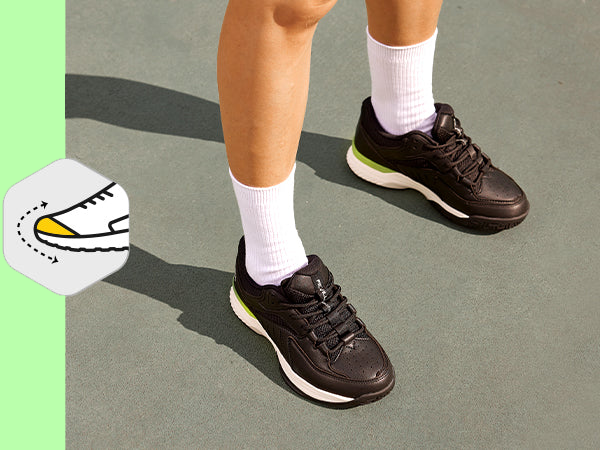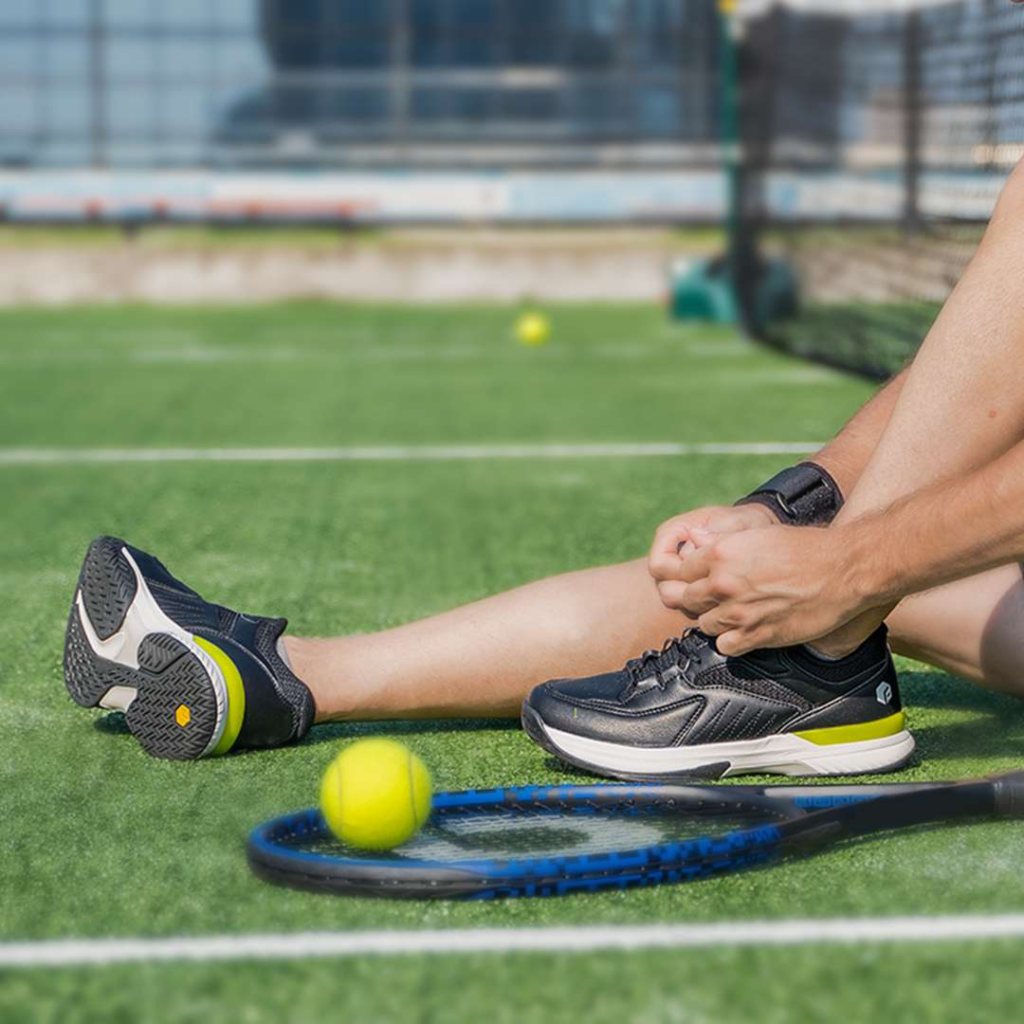How do Pickleball Shoes Differ from Running Shoes in Terms of Sole Design?
So, what are the differences between pickleball and running shoes? Pickleball shoes typically have flat, non-marking soles designed for quick lateral movements and stability on indoor or outdoor courts. On the other hand, running shoes have cushioned soles with various technologies optimized for forward motion.
You can also use the running shoes for pickleball games, but they may not provide the same level of traction on indoor pickleball courts.
So, here are the main differences between pickleball shoes and running shoes for wearing on the court.
Pickleball Shoes VS Running Shoes (Main Differences)
| Features Comparison | Pickleball Shoes | Running Shoes |
| Design | Low-profile with wider outsole | Cushioned with flexible outsole |
| Construction | Durable materials for lateral stability | Lightweight and breathable |
| Traction | Excellent multidirectional grip | Optimized for forward motion |
| Cushioning | Firmer cushioning for lateral movements | Softer cushioning for impact absorption |
| Support | Emphasis on stability and support | Focus on reducing impact on joints |
| Weight | Slightly heavier | Lighter for reduced fatigue |
| Main Focus | Lateral stability and agility | Forward motion and comfort |
1. Design and Construction
Pickleball Shoes – They are engineered to provide lateral stability, quick movements, and agility on the court. They typically feature a low-profile design with a broader outsole for better traction and lateral support.
However, the upper is often made of durable materials, such as synthetic leather or mesh, to provide stability and support during lateral movements.

Running Shoes – Running shoes prioritize forward motion and cushioning. They are designed to absorb impact, promote efficient stride, and provide comfort over long distances.
These shoes feature a more cushioned midsole and a flexible outsole to accommodate the repetitive nature of running. The upper is usually lightweight and breathable to enhance airflow.
2. Traction and Outsole
Pickleball Shoes – Due to the lateral movements involved, the outsoles of these shoes are designed to offer excellent traction and grip on indoor court surfaces.
They typically have patterns with a mix of herringbone or modified herringbone patterns to provide multidirectional stability and prevent slipping during quick lateral movements.
Running Shoes – The outsoles of running shoes are optimized for forward motion and typically have a combination of rubber and grooves to provide traction on various surfaces.
The patterns maximize grip while maintaining flexibility for a smooth heel-to-toe transition during the running gait cycle.
3. Cushioning and Support
Pickleball Shoes – Pickleball shoes focus on providing stability and support for lateral movements. They offer cushioning in the midsole to absorb shock and impact from sudden stops and lateral cuts.
The cushioning is often firmer to provide better responsiveness and prevent excessive foot movement inside the shoe during quick direction changes.

Running Shoes – Running shoes prioritize cushioning and shock absorption to reduce the impact on joints and muscles during repetitive forward movements.
They typically have ample cushioning in the heel and forefoot areas to provide a comfortable and responsive ride. The cushioning is usually softer to absorb the impact forces generated while running.
4. Weight
Pickleball Shoes – Pickleball shoes tend to be slightly heavier than running shoes. The added weight contributes to the stability and lateral support required for quick movements and direction changes on the court.
Running Shoes – Running shoes are generally lighter to minimize the weight burden during prolonged running activities. More lightweight shoes can enhance speed and reduce fatigue over long distances.
Differences Between Pickleball Court Shoes and Running Shoes
Although both types of shoes can be used for different sports, their performance and efficiency would be other if used for pickleball games.
Lateral Stability and Support
Cushioning and support are vital in pickleball shoes and the game itself. It is less essential as compared to lateral stability in addition to a lower-to-ground feel.
The player will feel more robust if the foot is close to the ground. It will feel more stable if it is lateral to the base. As lateral stability is necessary for pickleball games, cushioning in court shoes is less than in running shoes.

On the other hand, court shoes are specially designed for use on tennis and pickleball courts. At the same time, running shoes play a significant role and focus on cushioning, but court shoes emphasize support and lateral stability.
These two aspects are critical in pickleball games because quick moves are executed on the courts for side-to-side cuts instead of heel-to-toe running.
Cushioning
Running shoes are cushioned from toe to heel to reduce the impact from heel to toe when the shoe strikes the ground. On the other hand, there is much lateral stability in running shoes as it is significantly less because of side-to-side movements in running shoes, which is very uncommon.
Moreover, the style and design of running shoes stabilize, support, and cushion your feet and ankles. While running, you try to go in one direction, backward and forward. So running shoes help your body cope with the requirements of running.
Furthermore, according to the American Academy of Orthopedic Surgeons, cushioned shoes are also considered neutral. These shoes are made for people with high arches, and running shoes are ideal for those whose arches may collapse.
Durability and Sole
Pickleball courts and running shoes are considerably different insoles. Pickleball court shoes must be replaced and displaced when the player experiences wear through the outsoles and grind down the sole until it offers little traction and becomes even and smooth.
So, wearing court shoes is more durable and well made than running shoes as consistent starting, stopping, and sliding of pickleball shoes puts extensive strain on the sole, impacting their durability.
Running shoes should be discarded when they lose their spring and cushioning. It rarely happens due to holes in the shoe. The American Heart Association advises discarding your running shoes after running 350 to 500 miles when the tread will wear down.
Distribution of Weight
Regarding weight distribution, pickleball shoes have heel-toe drop as close to zero m millimeters as possible to a great extent.

Thus enabling you to turn on your heels and distribute your body weight evenly. So if you need special insoles in your shoes, you can remove genuine insoles from the inner of the shoe to insert them.
Running shoes have a slope called heel-toe drop in which the heel of the shoe is higher and comes with more cushioning than the toe box.
Where The Rubber Meets the Court
In pickleball shoes, the rubber used for the outsole is another part that offers durability over time. This rubber in the outsole is more rigid than rubber in typical running shoes, so it should be long-lasting for multiple years.
Lighter Tread
In running shoes, the design is only to hold your weight; in pickleball shoes, the tread is herringbone or squiggly lines on the bottom of the shoe. This type of tread offers complete traction, thus letting you rotate, push your weight, and lunge to move your body forward.
What Should You Wear to Play Pickleball? Tennis Shoes, Running or Walking Shoes?
Any court shoe would be the best option for playing pickleball. Wearing tennis shoes is suitable for pickleball because they minimize the risk of injuries and have more stability for lateral movements.
These shoes are also great to help to reduce the risk of falling and rolling on ankles.
However, any shoe made for indoor and outdoor hard courts is the best option compared to walking and running shoes. Court shoes have more durable outsoles that perform well in wooden and rubber-made courts. The outsoles of these shoes are made for sliding in many directions and can also deal with quick starts and stops.
Therefore walking and running shoes are not ideal for playing pickleball games because these two types are designed for something other than multiple directions and lateral movements. Running shoes are made for heel-to-toe strides, making you vulnerable to rolling on your ankle.
How Long Does a Pickleball Court Shoe Last?
The longevity of court shoes depends on various factors, including the quality of materials, frequency of use, playing style, and court surface. While providing an exact timeframe is challenging, a general estimate for the lifespan of court shoes is between 45 and 60 hours. However, it’s important to note that individual experiences may vary.
FAQs
Is it OK to wear running shoes for pickleball?
No running shoes are not an ideal option to play a pickleball game. Because the running shoes are made for forward moves, that does not offer the lateral stability needed for pickleball.
Can I wear court shoes for pickleball?
You can wear court shoes for pickleball because they have a herringbone pattern that offers the best traction for hard court surfaces. So the best tennis shoe for pickleball outdoor court will be any hard court shoe.
Can I use court shoes for running?
Wearing running shoes for tennis could lead to ankle injuries. So you will need more stability offered by the strong upper and tread. The additional stress on the shoe leads to replacing your running shoe quickly. On the other hand, wearing tennis shoes will not be a good experience for playing pickleball.
Final Thoughts
In the end, the right choice between pickleball Shoes and Running Shoes depends on your individual needs and the specific demands of your chosen activity. Whether you’re gliding across the pickleball court or pounding the pavement during your daily run, selecting the appropriate footwear is crucial for both performance and injury prevention.
So, take the time to evaluate your priorities, try different options, and make a decision that will support your active lifestyle and help you achieve your goals. Your feet will thank you for it!



